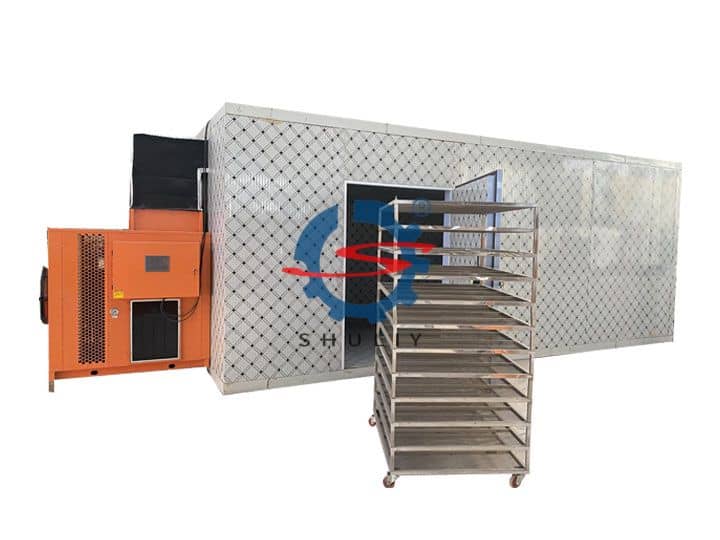Holzkohlebrikett-Trocknungsmaschine: Eine wesentliche Komponente für hochwertige Briketts
Holzkohlebriketts sind dank ihrer erneuerbaren Natur, niedrigen Kosten und umweltfreundlichen Eigenschaften eine zunehmend beliebte und nachhaltige Alternative zu herkömmlichen Brennstoffen. Um jedoch qualitativ hochwertige Briketts herzustellen, müssen die Rohstoffe eine Reihe von Prozessen durchlaufen, darunter Karbonisierung, Zerkleinerung und Trocknung. Dabei ist die Trocknungsphase von entscheidender Bedeutung, da sie die Leistung, Handhabung, Lagerung und Verbrennung der Briketts erheblich beeinflussen kann. Eine Holzkohlebrikett-Trocknungsmaschine ist eine Spezialausrüstung, die dazu dient, den Briketts Feuchtigkeit zu entziehen und deren Qualität und Effizienz zu verbessern. In diesem Artikel werden wir die Vorteile, Funktionen und Arten von Holzkohlebrikett-Trocknungsmaschinen untersuchen.

Vorteile der Holzkohlebrikett-Trocknungsmaschine
A charcoal briquette drying machine provides several benefits to the briquette production process, such as:
Faster and more efficient drying: Traditional air drying methods can take several days or even weeks, depending on the environmental conditions, and result in inconsistent and unstable moisture levels. In contrast, a drying machine can remove moisture from the briquettes quickly and reliably, typically within a few hours, with consistent and optimal drying conditions.
Improved briquette quality: Moisture in briquettes can cause several issues, such as reduced heat output, incomplete combustion, uneven burning, smoking, and foul odors. Additionally, the excess water content can affect the briquettes’ consistency and make them prone to breakage during handling, storage, and transportation. Moreover, moisture can foster the growth of fungi and bacteria, leading to spoilage and quality deterioration. Therefore, using a drying machine can reduce the moisture content to a safe and optimal level, improving the briquettes’ quality, performance, and durability.
Cost-effective and sustainable: Using a drying machine can reduce labor costs and improve productivity, as the machine can operate continuously and automatically without the need for manual intervention. Additionally, the drying machine can utilize various sources of energy, such as wood, coal, gas, or oil, making it a flexible and sustainable option.
Merkmale der Holzkohlebrikett-Trocknungsmaschine
Eine Trocknungsmaschine für Holzkohlebriketts besteht typischerweise aus den folgenden Komponenten:
Drying chamber: The chamber or drum is where the briquettes are loaded and undergo the drying process. The chamber’s size, shape, and material can vary depending on the machine’s capacity, design, and application.
Heat source: The heat source generates hot air or gas that circulates inside the chamber and removes moisture from the briquettes. The heat source can be a burner, boiler, stove, or any other type of heating device that burns fuel such as wood, coal, gas, or oil.
Fan or blower: The fan or blower circulates the hot air or gas inside the chamber, creating a convection current that enhances drying efficiency and uniformity.
Trays or racks: The trays or racks hold the briquettes and allow them to receive maximum exposure to hot air or gas. The trays or racks can be made of metal, wood, or any other suitable material, depending on the machine’s design.
Temperature and humidity control: The drying machine can control the temperature and humidity inside the chamber to ensure optimal and consistent drying conditions. Depending on the machine’s sophistication, the temperature and humidity control can be manual or automatic, using sensors, thermostats, or timers.
Arten von Holzkohlebrikett-Trocknungsmaschinen
Trocknungsmaschinen für Holzkohlebriketts können in zwei Haupttypen eingeteilt werden:
Direct drying machine: A direct drying machine uses direct heat transfer to remove moisture from the briquettes, typically by exposing them to hot air or gas directly. While direct drying can be faster and more efficient than indirect drying, it can also lead to overheating, burning, and uneven drying if not controlled properly.
Indirect drying machine: An indirect drying machine uses indirect heat transfer to remove moisture from the briquettes, typically by circulating hot air or gas indirectly through the trays or racks. Indirect drying can offer better temperature and humidity control, resulting in more consistent and high-quality drying.
Auswahl der richtigen Trocknungsmaschine für Holzkohlebriketts
Bei der Auswahl einer Holzkohlebrikett-Trocknungsmaschine müssen mehrere Faktoren berücksichtigt werden, wie zum Beispiel:
Capacity: The machine’s capacity should match the production volume and frequency of the briquettes. A machine that is too small or too large can result in inefficient drying and wasted energy.
Energy source: The energy source should be compatible with the availability, cost, and sustainability of the fuel. A machine that relies on fossil fuels can be more expensive and polluting than a machine that uses renewable energy sources such as biomass or solar.
Automation: The level of automation can affect the machine’s ease of use, productivity, and maintenance. A machine with advanced automation features can reduce labor costs and improve efficiency but may require higher upfront investment and technical expertise.
Quality and reliability: The machine should meet safety standards and quality certifications, have a durable and robust design, and come with warranty and after-sales support.
Abschluss
Eine Trocknungsmaschine für Holzkohlebriketts ist ein wesentlicher Bestandteil der Brikettproduktion, da sie die Qualität, Leistung und Effizienz der Briketts erheblich beeinflussen kann. Durch die Entfernung überschüssiger Feuchtigkeit kann eine Trocknungsmaschine die Verbrennung, Lagerung und Handhabung der Briketts verbessern und sie zu einer zuverlässigen und nachhaltigen Alternative zu herkömmlichen Brennstoffen machen. Bei der Auswahl einer Trocknungsmaschine für Holzkohlebriketts sollten Faktoren wie Kapazität, Energiequelle, Automatisierung und Qualität berücksichtigt werden, um optimale Leistung und Wert zu gewährleisten.
